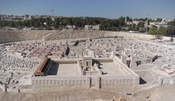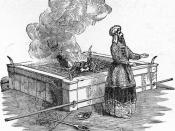The position of priesthood in the church has been evident since the earliest existence of the
church. Jewish priests first were established in the seventh century BC performing religious
ceremonies. They were even more established around 950 BC due to the establishment of
the Temple in Jerusalem.
The major role of the traditional Jewish priest was to perform sacrificial rituals.
According to the Bible, the Temple was built as a place for God to live with the people. It
was the holiest building that existed, and needed to be kept holy by the priests. Their role of
the priests was to perform animal sacrifices to God as an offering. The priests performed
these sacrifices as specialists on behalf of a community or congregation in order to restore the
holiness of the community and of the Temple. It was believed that if there was sin among the
people then God would not come and be with them.
After the Temple was destroyed during the war with Rome, these animal sacrifices
were stopped, and there were no more active Jewish priests. The religious leadership in the
synagogue was led by the rabbis.
In the Protestant religion there exists a 'priesthood of all believers'('Priesthood', 529).
This meant that each member in the community serves as his or her own priest, with direct
access to communication with God. Protestants believe that the role of the priest is an
'officiating mediary'('Priesthood', 529), rather than a one who performs ritual sacrifices. This
stems from the Protestant belief that Jesus Christ served as 'the ultimate' sacrifice, and
therefore there is no use in animal sacrifices. Protestants also do not call their religious leaders
'priests' because the name itself implies that he is of a higher level than his fellow man or that
he has more...


